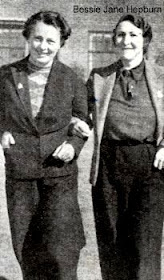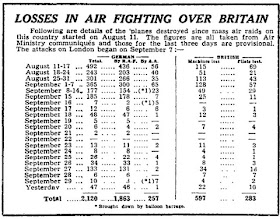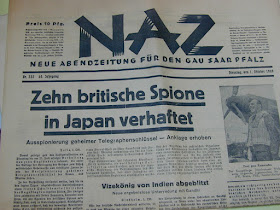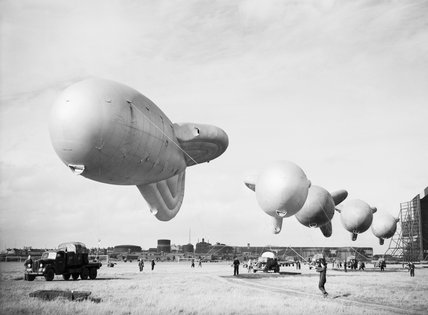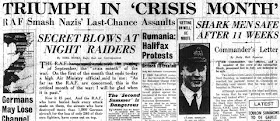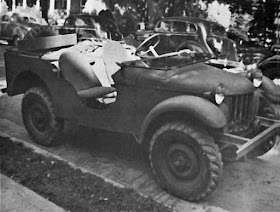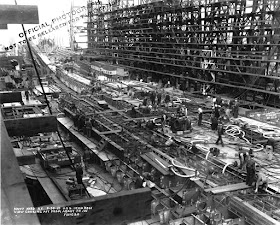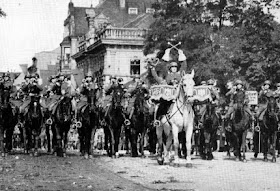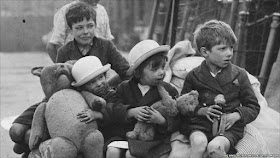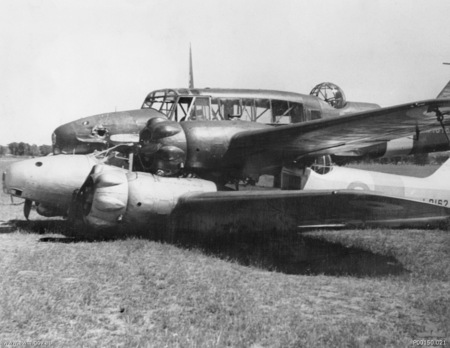Wednesday 2 October 1940
 |
| The crew of an RAF No. 83 Squadron Hampden exit the aircraft "after a successful night's work over Germany," Scampton, 2 October 1940. |
It is a cloudy, rainy day, giving the attacks some much-needed cover. The raids start early today, heading for London and nearby airfields such as RAF Biggin Hill around 07:15. RAF Penrhos (Gwynedd in Wales) takes a beating, with numerous ancillary buildings destroyed.
The first major attack starts to form at 08:30. when the Luftwaffe assembles a mixed formation of bombers, Jabos and fighters above Calais and sends it against London. RAF Fighter Command intercepts with 8 squadrons when they approach London. More formations follow, with the first group heading for central London and following formations branching off to surrounding areas. Some ancillary formations cross at different locations, creating a confusing picture for the RAF. The bombers generally reach their targets, and there are massive dogfights which result in few losses given the good cloud-cover.
A smaller raid crosses shortly before noon in the Maidstone area. This is a hit-and-run raid that bombs the coast there, but a larger, following formation heads for RAF Biggin Hill, RAF Lympne, and RAF Kenley and also east London and causing moderate damage.
After the by-now standard break for lunchtime, the Luftwaffe returns with moderate-sized (a few dozen aircraft) raids at 13:30 heading for the same Biggin Hill/Kenley/east London areas targeted during the morning. Once again, there are many ancillary raids of much smaller formations bombing other targets in East Kent such as Camberwell and Sheppey.
 |
| Hurricane pilot and ground staff inspect the oxygen supply, October 1940. The mechanics back at base get no recognition, but the pilots knew who the real heroes of the Battle of Britain were. |
Around dusk at 19:30, the Luftwaffe attacks a convoy off Peterhead with Heinkel He 115s, which have some luck (mentioned below). Fighter Command shoots down one Heinkel and damages another.
After dark, 180 Luftwaffe bombers queue up over London, Newcastle, Manchester, northwest Scotland and the Midlands. The raids are largely over by 01:00, much earlier than during September. The Luftwaffe also mines the Humber and the Thames Estuary. Overall, it is a fairly quiet night as these things have gone since the start of the Blitz on 7 September.
Losses are moderate, with the Luftwaffe losing about ten planes (half bombers, the rest Bf 109s) and the RAF apparently only one. The Luftwaffe's mix of fighters lost to bombers is "improving" in the sense that fewer bomber crews are being lost, though at the expense of more elite fighter pilots lost. Given the fact that there were bombers in only one moderate-sized raid throughout the raid, the attack around 16:30, a disproportionately high five Luftwaffe bomber losses just underscores how vulnerable they have become to the increasingly experienced and aggressive RAF fighter pilots.
For its part, the RAF is getting many more interceptors in the air at night - this time about 33 planes - but they remain singularly unsuccessful at intercepting the lumbering Luftwaffe bombers. The slow, largely unprotected Heinkel He 111s, Junkers Ju 88s, and Dornier Do 17s still can conduct their operations virtually unmolested after dark aside from anti-aircraft fire (admittedly extremely intense over the London Inner Artillery Zone).
During the morning dogfights, some pilots of JG 53 claim to have a big day. Lt. Eric Schmidt and Uffz. Robert Wolfgarten, both from 9./JG 53, combine for claims of four Spitfires. RAF records, though, only report the loss of one plane during the day, so there was some, ah, German confusion over England.
An unusual incident happens in the morning when the crew of a meteorological/reconnaissance Junkers Ju 88 bomber - still a new entrant on the scene - gets disoriented. After departing Amsterdam Schiphol at 03:00, it wanders about in the dark, cloudy night and mistakes England for France (hey, it happens a lot during the war). Landing at 06:30, the RAF gets a perfectly good new plane for its "Ratwaffe," the British collection of intact captured aircraft.
Battle of the Atlantic: U-32 (Kplt. Hans Jenisch) torpedoes and sinks 4606-ton British freighter Kayeson along the trade routes 400 or so miles west of Ireland at 18:25. All 38 onboard are seen by the U-boat to abandon ship, but none are ever seen again - Captain Jenisch notes high swells. The U-boat accidentally collides with the Kayeson's rudder and sustains damage and, since it is now out of torpedoes, heads for home. This is one of several incidents around this time when entire crews mysteriously disappear in the mid-Atlantic.
The Luftwaffe Focke Wulf Fw 200 Condors of 2,/KG 40 attack Convoy HG 44 a few miles west of County Kerry, Ireland. Oberleutnant Schlosser hits 2218 ton British freighter Latymer with a 250kg bomb and sinks it. There is some confusion about this sinking because the wreck site is west of Ireland, but she was heading from Lisbon to London and that was far out of her way. The ship may have been re-routed, but sending it clear around Ireland seems kind of odd. There was at least one fatality for this sinking, a seaman listed on the Plaques All Wars Seamen's Mission in South Shields (currently on the staircase).
RAF No. 801 Squadron based at Hatson bombs German shipping at Bjorne Fjord and lose a Skua, the two airmen perish.
The Luftwaffe attacks Convoy HX 74 off Scotland in the North Sea, but they cause no damage. However, in another attack off Peterhead against Convoy HX 74A, they damage freighter Trehata.
Convoy FN 297 departs from Southend, Convoy FS 298 departs from Methil.
U-144 (Kptl. Friedrich von Hippel) is commissioned.
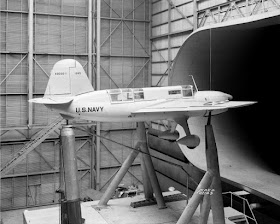 |
| The Curtiss SO3C Seamew developed by the Curtiss-Wright Corporation in a wind tunnel, October 1940. |
The Royal Navy fleet returns to Alexandria after its successful resupply mission to Malta.
Cruisers HMS Orion and Sydney attack the Italian base at the port of Maltezana on Stampalia (Astypalaia).
The Malta command, realizing how easy it is to confuse Royal Navy submarines and Italian ones (there are no U-boats in the Mediterranean at this time), develops a new protocol. Coastal batteries from now on will be given a stand-down order when Royal Navy submarines are known to be in the vicinity. The first such stand-down order (called "submarine sanctuary" orders, which is somewhat misleading) are issued today for the anticipated arrival of HMS Truant. Meanwhile, the infantry and artillery units on the island continue integrating the troops received in the recent convoy from Alexandria.
Anglo/US Relations: Pursuant to the destroyers-for-bases deal, the USS Mason (DD 191) becomes the HMS Broadwater (H 81, Lt. Commander Charles L. de Hauteville Bell).
The Greenslade Board inspecting the new US bases from that deal arrives at Guantanamo Bay, Cuba.
 |
| "ON BOARD ONE OF THE US DESTROYERS RECENTLY TRANSFERRED TO THE ROYAL NAVY. 2 OCTOBER 1940, PLYMOUTH." © IWM (A 1062). |
Holocaust: Adolf Hitler meets in Berlin with Hans Frank, the Gauleiter in Occupied Poland. He sets forth his views about the Poles (notes of the meeting by Martin Bormann):
The General Gouvernment is our work force reservoir for low-grade work (brick plants, road building, etc.) ... Unconditionally, attention should be paid to the fact that there can be no "Polish masters"; where there are Polish masters, and I do not care how hard this sounds, they must be killed. (...) The Führer must emphasize once again that for Poles there is only one master and he is a German, there can be no two masters beside each other and there is no consent to such, hence all representatives of the Polish intelligentsia are to be killed ... The General Gouvernment is a Polish reservation, a great Polish labor camp.In essence, Hitler sets forth the view that the Poles exist only to service the German war effort as slaves and otherwise are useless and unnecessary. This also is direct evidence of Hitler ordering executions of "undesirables." The issue of the Poles will remain an active topic until the last days of the Reich and will not deviate from this attitude. One last fact: many of the Polish "intelligentsia" (but not by any means all) are Jewish.
Free France: The British and General de Gaulle are having "issues." The Royal Navy sends the transports loaded with the troops intended for Operation Menace from Freetown to join de Gaulle at Duala, Cameroon. However, disagreements about objectives arrive, and the British turn the transports around and they return to Freetown. De Gaulle's prestige is at a low point due to the fiasco at Dakar.
British Homefront: The government formally ends the Children's Overseas Reception Board (CORB) due to the recent sinkings of the Volendam and City of Benares (the latter sinking on 18 September 1940 decisive because of the large loss of life by the evacuees).
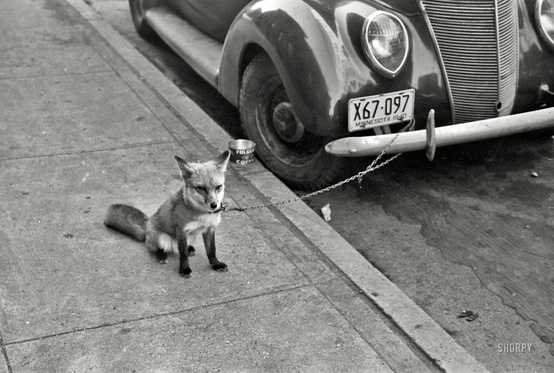 |
| A pet fox waiting for its owner, Owning unusual pets was a big fad in the 30s-50s and included deer and pigs. Moorhead, Minnesota, October 1940. |
October 1940
October 1, 1940: Wait Daddy October 2, 1940: Hitler's Polish Plans
October 3, 1940: British Cabinet Shakeup
October 4, 1940: Brenner Pass Meeting
October 5, 1940: Mussolini Alters Strategy
October 6, 1940: Iron Guard Marches
October 7, 1940: McCollum Memo
October 8, 1940: Germans in Romania
October 9, 1940: John Lennon Arrives
October 10, 1940: Führer-Sofortprogramm
October 11, 1940: E-Boats Attack!
October 12, 1940: Sealion Cancelled
October 13, 1940: New World Order
October 14, 1940: Balham Tragedy
October 15, 1940: Mussolini Targets Greece
October 16, 1940: Japanese Seek Oil
October 17, 1940: RAF Shakeup
October 18, 1940: Convoy SC-7 Catastrophe
October 19, 1940: Convoy HX-79 Catastrophe
October 20, 1940: Convoy OB-229 Disaster
October 21, 1940: This Evil Man Hitler
October 22, 1940: Aktion Wagner-Burckel
October 23, 1940: Hitler at Hendaye
October 24, 1940: Hitler and Petain
October 25, 1940: Petain Woos Churchill
October 26, 1940: Empress of Britain Attack
October 27, 1940: Greece Rejects Italian Demands
October 28, 1940: Oxi Day
October 29, 1940: US Draft Begins
October 30, 1940: RAF Area Bombing Authorized
October 31, 1940: End of Battle of Britain
2020
